Do not trust fake "DHL Express - Incomplete Delivery Address" emails
Phishing/ScamAlso Known As: "DHL Express - Incomplete Delivery Address" phishing email
Get free scan and check if your device is infected.
Remove it nowTo use full-featured product, you have to purchase a license for Combo Cleaner. Seven days free trial available. Combo Cleaner is owned and operated by RCS LT, the parent company of PCRisk.com.
What kind of email is "DHL Express - Incomplete Delivery Address"?
After inspecting the "DHL Express - Incomplete Delivery Address" email, we determined that it is fake. This spam letter promotes a phishing scam. It lures recipients into disclosing their email log-in credentials by claiming that their package could not be sent due to an error in the delivery address.
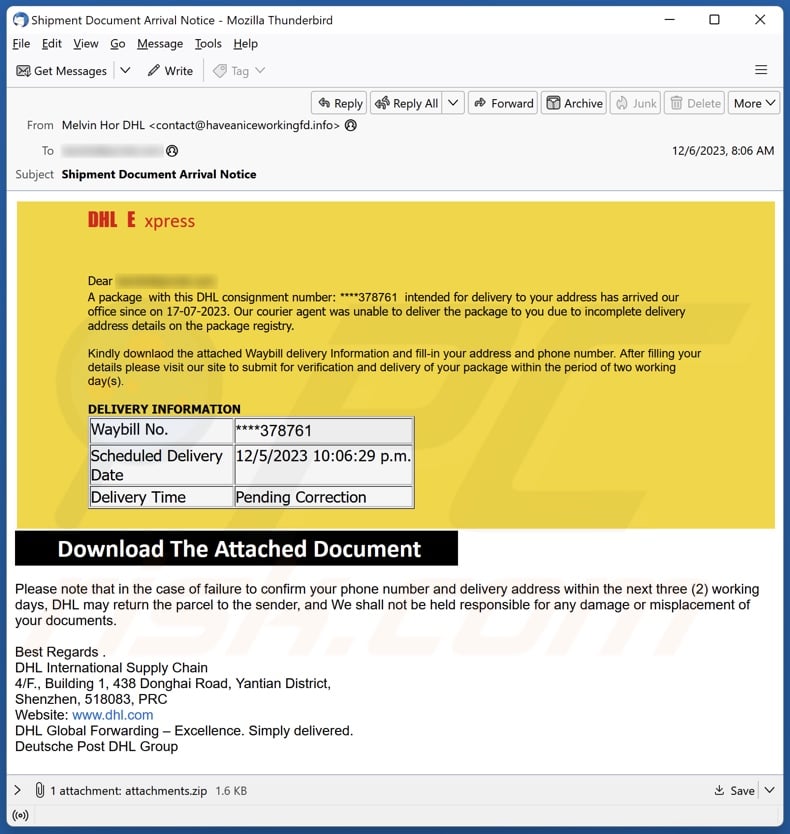
"DHL Express - Incomplete Delivery Address" email scam overview
The spam email with the subject "Shipment Document Arrival Notice" (may vary) informs the recipient that the courier agent could not deliver their package. The reason provided is a mistake in the delivery address.
The recipient is required to download the attached waybill and provide their address and telephone number. Once the filling is completed and verification is done on the courier company's webpage, the package will be delivered within two work days.
As mentioned in the introduction, all the claims made by this email are false, and this mail is in no way associated with the DHL logistics company or any other legitimate entities.
The archive attached to this mail ("attachmets.zip") includes a phishing file ("Original BL CI Copies.shtml"). Information entered into the latter is recorded and sent to scammers. This file targets email account log-in credentials but might also be used to collect other private data (e.g., names, addresses, telephone numbers, etc.).
Victims of scams like "DHL Express - Incomplete Delivery Address" risk more than just losing their email. Mail accounts are commonly used to register other content; hence, access/control might be gained over accounts and platforms linked to a stolen email.
To elaborate, scammers can steal the identities of social account owners (e.g., emails, messengers, social networking, social media, etc.) and ask the contacts/friends/followers for loans or donations, promote scams, and proliferate malware by sharing malicious links or files.
Hijacked finance-related accounts (e.g., online banking, money transferring, e-commerce, cryptocurrency wallets, etc.) can be used to make fraudulent transactions and/or online purchases.
To summarize, by trusting an email like "DHL Express - Incomplete Delivery Address" – users can experience severe privacy issues, financial losses, and even identity theft.
If you have already provided your log-in to cyber criminals – change the passwords of all possibly compromised accounts and inform their official support without delay. If you've disclosed other private data (e.g., ID card details, passport photos/scans, credit card numbers, etc.) – immediately contact the corresponding authorities.
| Name | "DHL Express - Incomplete Delivery Address" phishing email |
| Threat Type | Phishing, Scam, Social Engineering, Fraud |
| Fake Claim | Recipient's package could not be delivered due an incomplete delivery address. |
| Disguise | DHL Express |
| Attachment(s) | "attachmets.zip" containing "Original BL CI Copies.shtml" (filenames may vary) |
| Detection Names | Avast (HTML:PhishingDhl-DM [Phish]), DrWeb (HTML.FishForm.569), ESET-NOD32 (HTML/Phishing.DHL.FV), Fortinet (HTML/Phishing.FV!tr), GData (HTML.Trojan.Agent.CG6NHW), Full List Of Detections (VirusTotal) |
| Symptoms | Unauthorized online purchases, changed online account passwords, identity theft, illegal access of the computer. |
| Distribution methods | Deceptive emails, rogue online pop-up ads, search engine poisoning techniques, misspelled domains. |
| Damage | Loss of sensitive private information, monetary loss, identity theft. |
| Malware Removal (Windows) |
To eliminate possible malware infections, scan your computer with legitimate antivirus software. Our security researchers recommend using Combo Cleaner. Download Combo CleanerTo use full-featured product, you have to purchase a license for Combo Cleaner. 7 days free trial available. Combo Cleaner is owned and operated by RCS LT, the parent company of PCRisk.com. |
Phishing spam campaign examples
We have examined countless spam emails; "Email Authentication Expires", "IPS Pending Package Delivery", and "DHL Unpaid Duty" are merely a couple examples of letters used for phishing. These scams primarily target log-in credentials, personally identifiable details, and finance-related information.
Various false claims are used to entice or pressure users into disclosing data, e.g., shipping mishaps, subscription cancellations/renewals, message delivery issues, pending account deactivation, lotteries won, inheritances, and so forth. Other scams are promoted through spam as well, and it is used to distribute malware.
How do spam campaigns infect computers?
Spam emails/messages can have malicious files attached to or linked inside them. These files come in various formats, e.g., archives (ZIP, RAR, etc.), executables (.exe, .run, etc.), documents (Microsoft Office, Microsoft OneNote, PDF, etc.), JavaScript, and so forth. Once opened, an infectious file begins downloading/installing malware.
Some formats can require additional interaction to jumpstart system infection processes. For example, Microsoft Office files need users to enable macro commands (i.e., editing/content), while OneNote documents require them to click on embedded files/links.
How to avoid installation of malware?
We strongly advise treating incoming emails and other messages with caution. Attachments or links present in suspicious mail must not be opened, as they can be virulent. We recommend using post-2010 Microsoft Office versions since their "Protected View" mode prevents automatic macro command execution.
However, malware is not proliferated exclusively via spam mail. Since fraudulent and malicious online content usually appears legitimate and innocuous – we strongly recommend being vigilant while browsing.
Furthermore, dubious download channels (e.g., freeware and free file-hosting sites, P2P sharing networks, etc.) are used to spread malicious programs – therefore, download only from official and verified sources.
Another recommendation is to activate and update software by using legitimate functions/tools, as illegal activation ("cracking") tools and third-party updaters can contain malware.
We must emphasize that having a reputable anti-virus installed and kept updated is essential to device/user safety. This software must be used to run regular system scans and to remove detected threats. If you've already opened malicious attachments, we recommend running a scan with Combo Cleaner Antivirus for Windows to automatically eliminate infiltrated malware.
Text presented in the "DHL Express - Incomplete Delivery Address" spam email letter:
Subject: Shipment Document Arrival Notice
DHL Express
Dear ********
A package with this DHL consignment number: ****378761 intended for delivery to your address has arrived our office since on 17-07-2023. Our courier agent was unable to deliver the package to you due to incomplete delivery address details on the package registry.
Kindly downlaod the attached Waybill delivery Information and fill-in your address and phone number. After filling your details please visit our site to submit for verification and delivery of your package within the period of two working day(s).
DELIVERY INFORMATION
Waybill No. ****378761
Scheduled Delivery Date 12/5/2023 10:06:29 p.m.
Delivery Time Pending Correction
Download The Attached Document
Please note that in the case of failure to confirm your phone number and delivery address within the next three (2) working days, DHL may return the parcel to the sender, and We shall not be held responsible for any damage or misplacement of your documents.
Screenshot of the phishing file attached to this spam email ("Original BL CI Copies.shtml"):
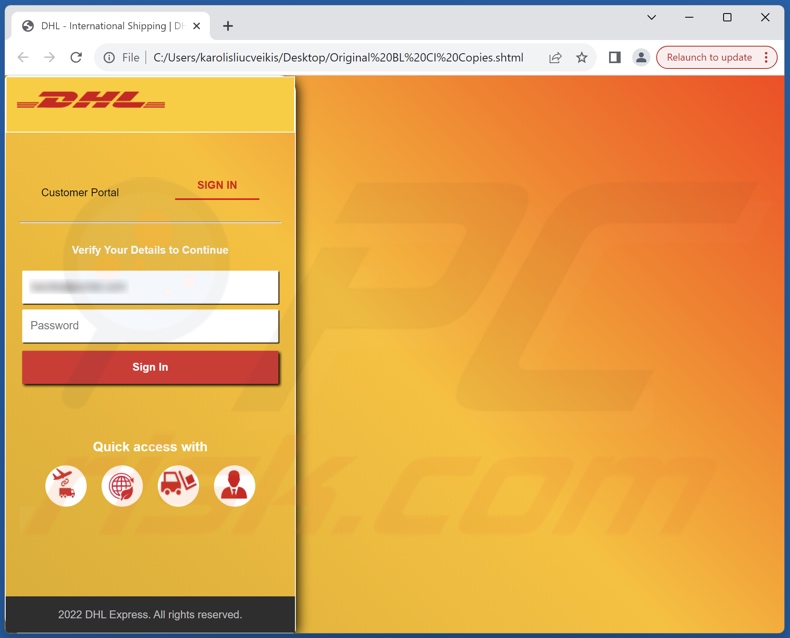
Another example of spam email from "DHL Express - Incomplete Delivery Address" spam campaign:
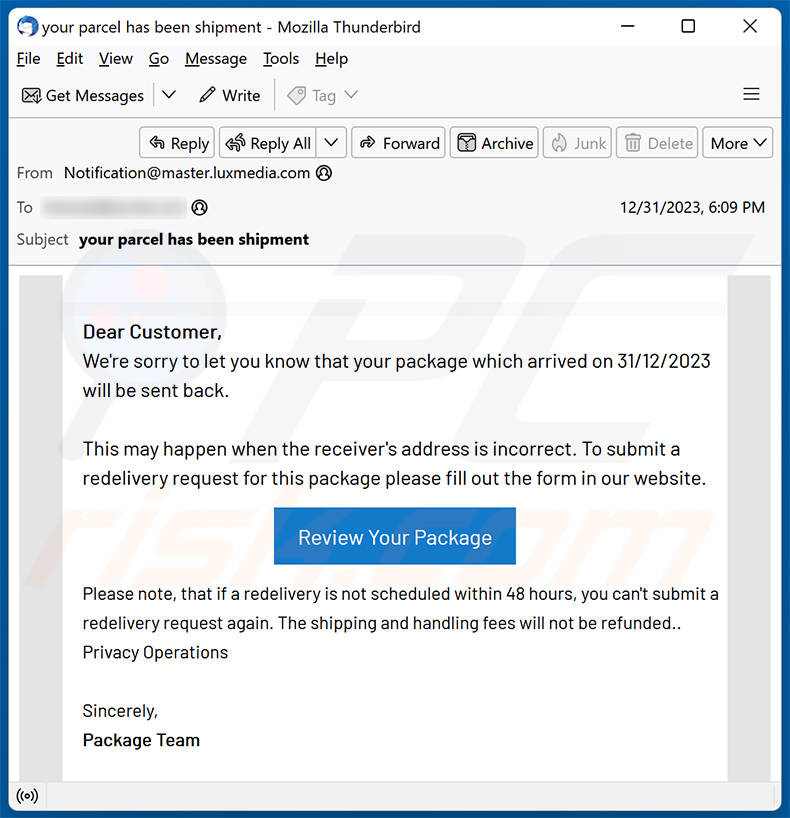
Text presented within:
Subject: your parcel has been shipment
Dear Customer,
We're sorry to let you know that your package which arrived on 31/12/2023 will be sent back.This may happen when the receiver's address is incorrect. To submit a redelivery request for this package please fill out the form in our website.
Review Your Package
Please note, that if a redelivery is not scheduled within 48 hours, you can't submit a redelivery request again. The shipping and handling fees will not be refunded..
Privacy OperationsSincerely,
Package Team
Screenshot of the promoted phishing site:
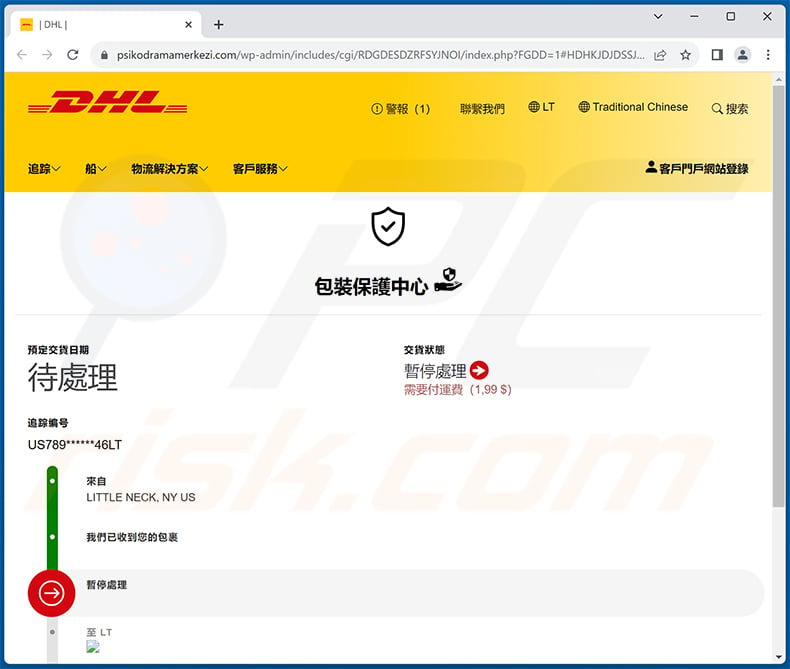
An Italian variant of "DHL Express - Incomplete Delivery Address" spam email:
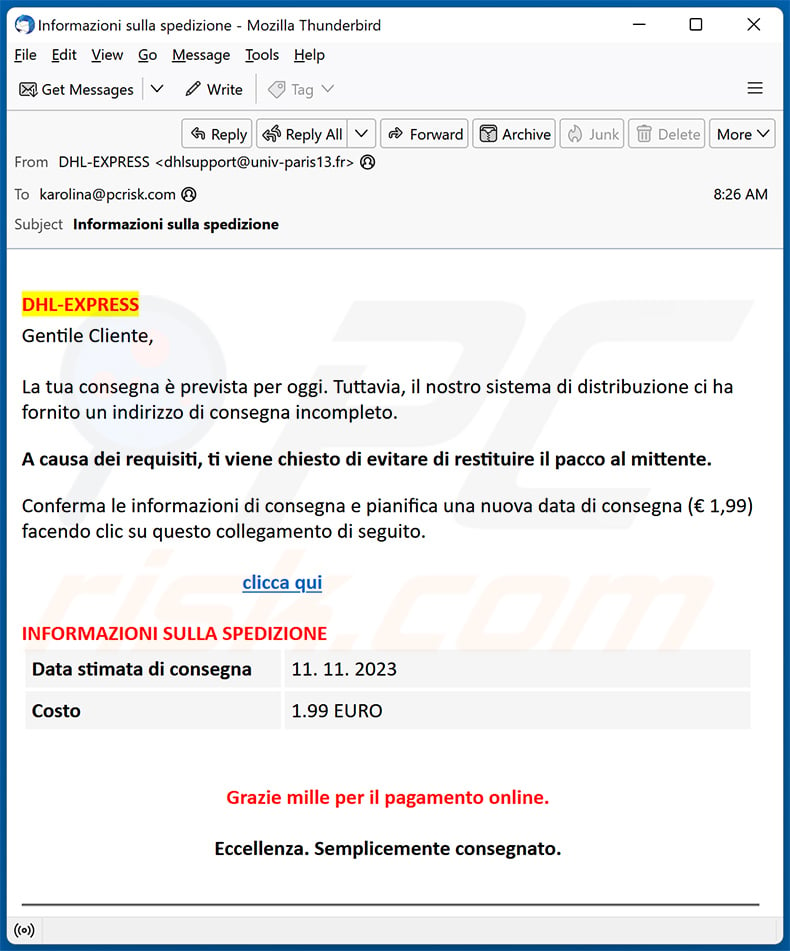
Text presented within:
Subject: Informazioni sulla spedizione
DHL-EXPRESS
Gentile Cliente,La tua consegna è prevista per oggi. Tuttavia, il nostro sistema di distribuzione ci ha fornito un indirizzo di consegna incompleto.
A causa dei requisiti, ti viene chiesto di evitare di restituire il pacco al mittente.
Conferma le informazioni di consegna e pianifica una nuova data di consegna (€ 1,99) facendo clic su questo collegamento di seguito.
clicca qui
INFORMAZIONI SULLA SPEDIZIONE
Data stimata di consegna
11. 11. 2023
Costo 1.99 EUROGrazie mille per il pagamento online.
Eccellenza. Semplicemente consegnato.
Screenshot of the promoted phishing site:
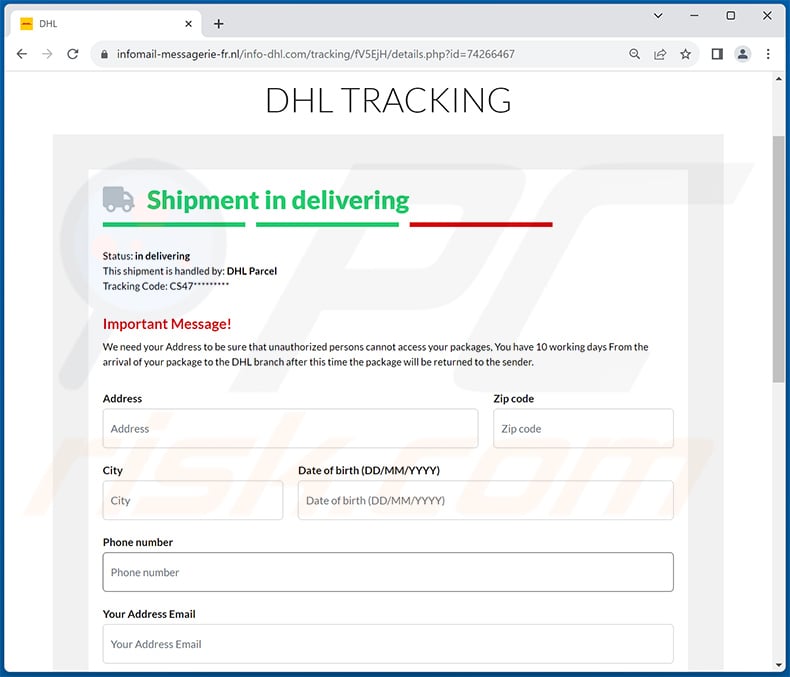
Instant automatic malware removal:
Manual threat removal might be a lengthy and complicated process that requires advanced IT skills. Combo Cleaner is a professional automatic malware removal tool that is recommended to get rid of malware. Download it by clicking the button below:
DOWNLOAD Combo CleanerBy downloading any software listed on this website you agree to our Privacy Policy and Terms of Use. To use full-featured product, you have to purchase a license for Combo Cleaner. 7 days free trial available. Combo Cleaner is owned and operated by RCS LT, the parent company of PCRisk.com.
Quick menu:
- What is "DHL Express - Incomplete Delivery Address" phishing email?
- Types of malicious emails.
- How to spot a malicious email?
- What to do if you fell for an email scam?
Types of malicious emails:
![]() Phishing Emails
Phishing Emails
Most commonly, cybercriminals use deceptive emails to trick Internet users into giving away their sensitive private information, for example, login information for various online services, email accounts, or online banking information.
Such attacks are called phishing. In a phishing attack, cybercriminals usually send an email message with some popular service logo (for example, Microsoft, DHL, Amazon, Netflix), create urgency (wrong shipping address, expired password, etc.), and place a link which they hope their potential victims will click on.
After clicking the link presented in such email message, victims are redirected to a fake website that looks identical or extremely similar to the original one. Victims are then asked to enter their password, credit card details, or some other information that gets stolen by cybercriminals.
![]() Emails with Malicious Attachments
Emails with Malicious Attachments
Another popular attack vector is email spam with malicious attachments that infect users' computers with malware. Malicious attachments usually carry trojans that are capable of stealing passwords, banking information, and other sensitive information.
In such attacks, cybercriminals' main goal is to trick their potential victims into opening an infected email attachment. To achieve this goal, email messages usually talk about recently received invoices, faxes, or voice messages.
If a potential victim falls for the lure and opens the attachment, their computers get infected, and cybercriminals can collect a lot of sensitive information.
While it's a more complicated method to steal personal information (spam filters and antivirus programs usually detect such attempts), if successful, cybercriminals can get a much wider array of data and can collect information for a long period of time.
![]() Sextortion Emails
Sextortion Emails
This is a type of phishing. In this case, users receive an email claiming that a cybercriminal could access the webcam of the potential victim and has a video recording of one's masturbation.
To get rid of the video, victims are asked to pay a ransom (usually using Bitcoin or another cryptocurrency). Nevertheless, all of these claims are false - users who receive such emails should ignore and delete them.
How to spot a malicious email?
While cyber criminals try to make their lure emails look trustworthy, here are some things that you should look for when trying to spot a phishing email:
- Check the sender's ("from") email address: Hover your mouse over the "from" address and check if it's legitimate. For example, if you received an email from Microsoft, be sure to check if the email address is @microsoft.com and not something suspicious like @m1crosoft.com, @microsfot.com, @account-security-noreply.com, etc.
- Check for generic greetings: If the greeting in the email is "Dear user", "Dear @youremail.com", "Dear valued customer", this should raise suspiciousness. Most commonly, companies call you by your name. Lack of this information could signal a phishing attempt.
- Check the links in the email: Hover your mouse over the link presented in the email, if the link that appears seems suspicious, don't click it. For example, if you received an email from Microsoft and the link in the email shows that it will go to firebasestorage.googleapis.com/v0... you shouldn't trust it. It's best not to click any links in the emails but to visit the company website that sent you the email in the first place.
- Don't blindly trust email attachments: Most commonly, legitimate companies will ask you to log in to their website and to view any documents there; if you received an email with an attachment, it's a good idea to scan it with an antivirus application. Infected email attachments are a common attack vector used by cybercriminals.
To minimise the risk of opening phishing and malicious emails we recommend using Combo Cleaner Antivirus for Windows.
Example of a spam email:

What to do if you fell for an email scam?
- If you clicked on a link in a phishing email and entered your password - be sure to change your password as soon as possible. Usually, cybercriminals collect stolen credentials and then sell them to other groups that use them for malicious purposes. If you change your password in a timely manner, there's a chance that criminals won't have enough time to do any damage.
- If you entered your credit card information - contact your bank as soon as possible and explain the situation. There's a good chance that you will need to cancel your compromised credit card and get a new one.
- If you see any signs of identity theft - you should immediately contact the Federal Trade Commission. This institution will collect information about your situation and create a personal recovery plan.
- If you opened a malicious attachment - your computer is probably infected, you should scan it with a reputable antivirus application. For this purpose, we recommend using Combo Cleaner Antivirus for Windows.
- Help other Internet users - report phishing emails to Anti-Phishing Working Group, FBI’s Internet Crime Complaint Center, National Fraud Information Center and U.S. Department of Justice.
Frequently Asked Questions (FAQ)
Why did I receive this email?
Regardless of any relevant details they may include, spam emails are not personal. This mail is distributed in massive campaigns – hence, thousands of users receive identical messages.
I have provided my personal information when tricked by this spam email, what should I do?
If you have disclosed your log-in credentials – change the passwords of all potentially compromised accounts and inform their official support. However, if the provided information was of a different personal nature (e.g., ID card details, passport scans/photos, credit card numbers, etc.) – immediately contact relevant authorities.
I have read a spam email but didn't open the attachment, is my computer infected?
Merely opening/reading an email will not trigger any malware download/installation chains; systems are infected when malicious attachments or links are opened/clicked.
I have downloaded and opened a file attached to a spam email, is my computer infected?
That depends on the opened file's purpose (i.e., phishing vs. malware infiltration), and it might be impacted by the format. Executables (.exe, .run, etc.) infect devices almost without fail once opened. While documents (.doc, .xls, .one, .pdf, etc.) may need extra actions (e.g., enabling macro commands, clicking embedded content, etc.) to start downloading/installing malware.
Will Combo Cleaner remove malware infections present in email attachments?
Yes, Combo Cleaner is capable of detecting and eliminating practically all known malware infections. Keep in mind that since sophisticated malicious programs typically hide deep within systems – performing a complete system scan is key.
Share:

Tomas Meskauskas
Expert security researcher, professional malware analyst
I am passionate about computer security and technology. I have an experience of over 10 years working in various companies related to computer technical issue solving and Internet security. I have been working as an author and editor for pcrisk.com since 2010. Follow me on Twitter and LinkedIn to stay informed about the latest online security threats.
PCrisk security portal is brought by a company RCS LT.
Joined forces of security researchers help educate computer users about the latest online security threats. More information about the company RCS LT.
Our malware removal guides are free. However, if you want to support us you can send us a donation.
DonatePCrisk security portal is brought by a company RCS LT.
Joined forces of security researchers help educate computer users about the latest online security threats. More information about the company RCS LT.
Our malware removal guides are free. However, if you want to support us you can send us a donation.
Donate
▼ Show Discussion